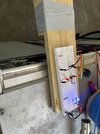Hi folks, I'm wondering if anyone could point me in the right direction. I am trying to build a device to push a button for me using a solenoid push actuator. Would the attached circuit work?
I'm sure there is a better way of doing it? And pointers would be great I'm not traditionally an electronics guy.
Thanks
I'm sure there is a better way of doing it? And pointers would be great I'm not traditionally an electronics guy.
Thanks




